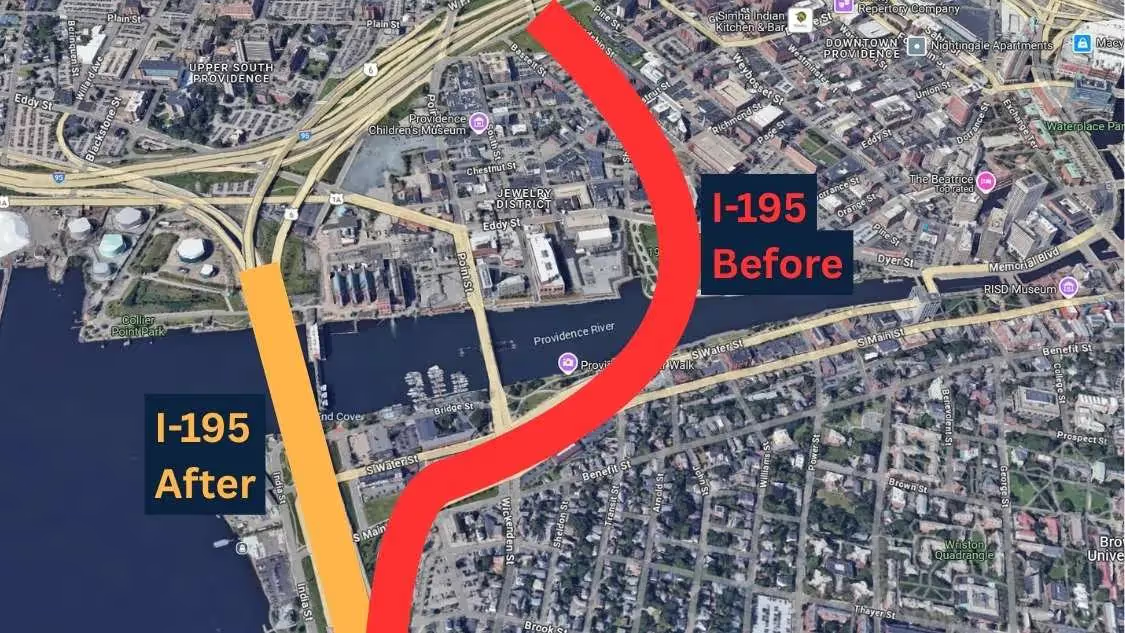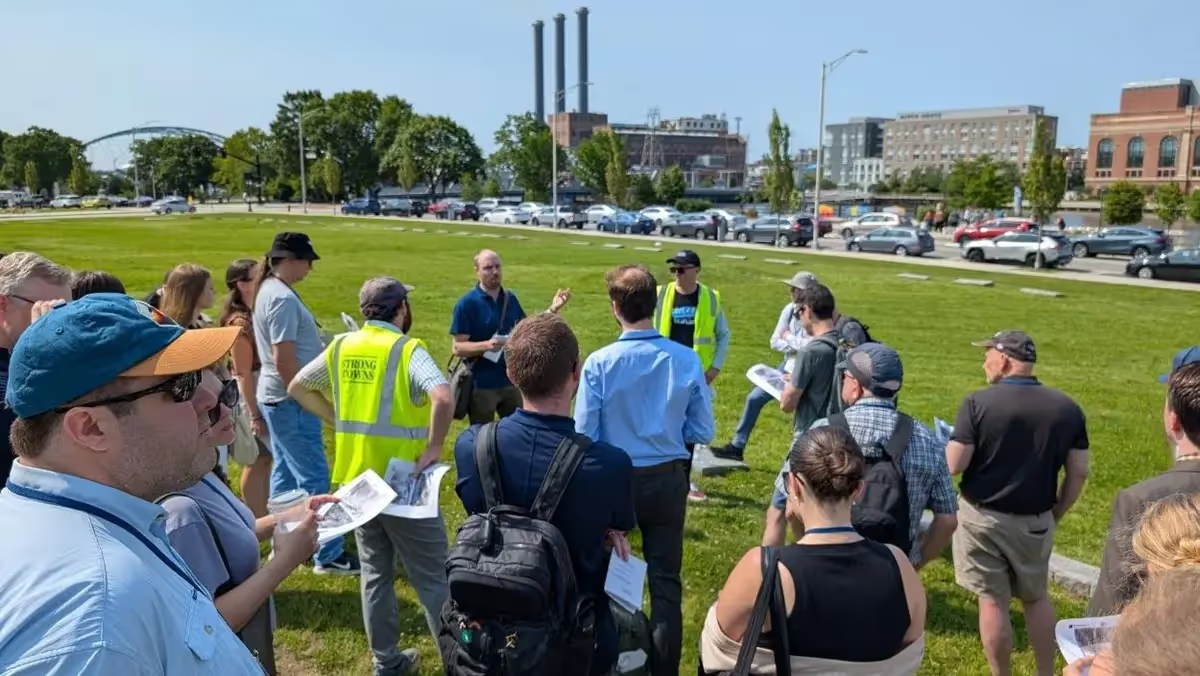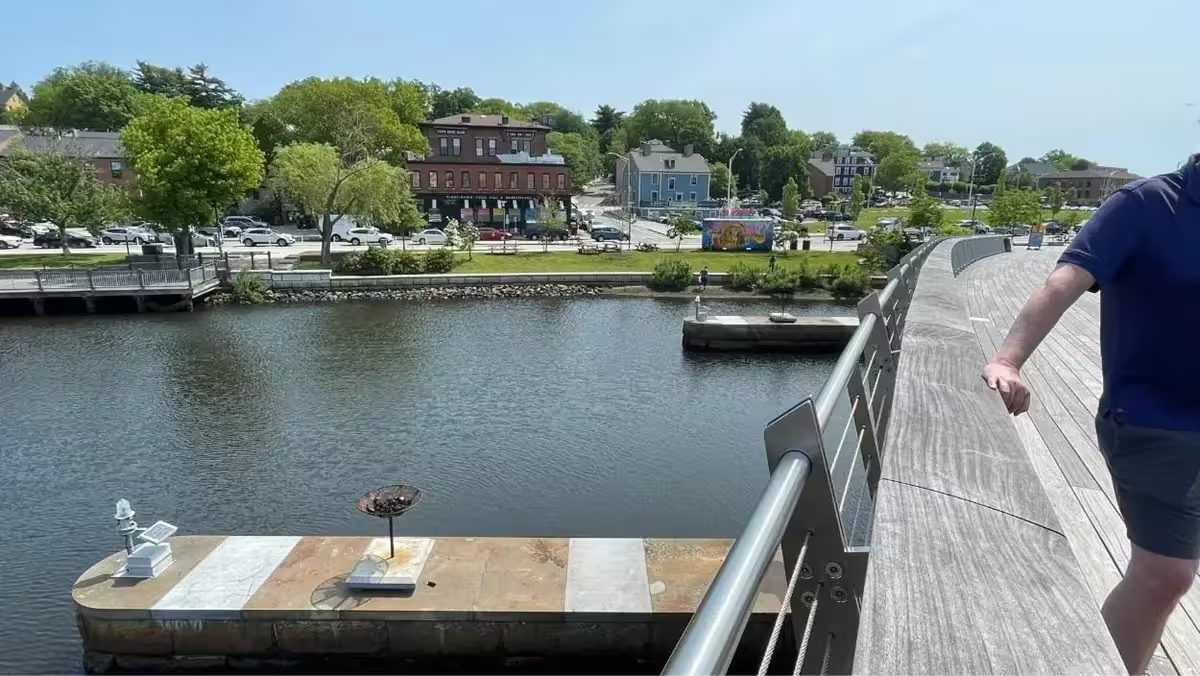Interstate 195 used to cut right through the heart of Providence, Rhode Island. The elevated highway divided communities, consumed dozens of acres of the city’s most valuable land, and made the surrounding areas less safe. This is not a unique problem. Cities across North America are struggling in the wake of urban renewal, a redevelopment approach that bulldozed “blighted” areas — which were often the most productive parts of cities — and replaced them with highways. Providence’s story is unique, though, because of what came next: The Rhode Island Department of Transportation (RIDOT) removed the highway from the urban core in 2011.
Last month, I attended a walking tour of the area as part of the 2025 Strong Towns National Gathering. Our guides were Dylan Giles of Providence Streets Coalition, Peter Erhartic of Building Block Community Development, and Kip Santos of Strong Towns Providence. It was an inspiring walk. Removing urban highways is one of the most difficult challenges in the Strong Towns playbook, and it was amazing to stand on the beautiful riverside knowing that, a few years ago, I would’ve been standing under an eight-lane highway, with all the noise and danger that came along with it.
So, how did they pull it off? Some of it was arguably luck — there were some very specific circumstances that helped in the removal of the highway — but a lot of it came down to leveraging local context and being willing to take small steps.
Here are three things I learned during the walking tour:
1. Politically Feasible Is Better Than Perfect
There were three main factors that made the removal of I-195 politically feasible:
First, removing the highway from the urban core didn’t mean getting rid of it entirely. While completely removing the highway would have been ideal, that would have been a much harder sell, our guides explained. Instead, officials removed the highway from the center of the neighborhood and placed it somewhere it would cause less damage.
Second, the original placement of the highway made no sense — even for cars. As you can see in the image below, the original section of I-195 curved through the center of the neighborhood, which caused more damage and was less efficient for drivers. In contrast, the modern section is a shorter straight line that sticks to the edge of the neighborhood, reducing its impact and improving traffic efficiency.

Finally, the highway had to be replaced either way. By 2010, I-195 had deteriorated badly enough that it needed to be replaced entirely, our guides said. This made removal far more politically feasible. The impression I got was that the money and labor would be spent either way, so RIDOT figured it might as well move the highway to a more logical place rather than rebuild it in the same, inefficient location.
2. Leverage Existing Value To Create More Value
One of the main benefits of removing an urban highway is the economic benefit it provides the community. The land in the heart of a city is a finite resource, with the ability to accumulate an enormous amount of wealth over time. Highways are an extremely unproductive use of that land, and redeveloping them can bring in a lot of money for the city. For example, Rochester, New York, redeveloped part of an urban highway and attracted well over $200 million in private investment — and that’s with only six acres of reclaimed land!
Sometimes, the existing value of the land can make highway removal more feasible in the first place. Our guides pointed out that the land I-195 ran through had extremely high value and desirability, even with the highway. On one side of the river is Brown University — an Ivy League school — as well as a thriving neighborhood. On the other side is Brown’s medical school and Providence’s downtown core. That existing value made the area more appealing to developers and investors.
3. Develop Where the Market Demands It
The removal of I-195 freed up 26 acres of prime land in the middle of Providence. Rebuilding that much land is difficult because cities are complex systems. You’re dealing with several neighborhoods, all of which may have different characters and needs, our guides explained. Instead of trying to redevelop the land all at once, they suggest breaking it up into smaller sections and focusing first on the areas where market demand is highest.
In the case of I-195, the neighborhood on the east side of the river was a smaller-scale residential area, while the west side featured much larger-scale buildings, including commercial and industrial uses. In 2011, there was a ton of demand for housing and barely any for commercial spaces. So, the commission in charge of development focused on building housing at various scales. Over time, as people moved in, demand for commercial buildings in the area increased and they could start redeveloping the rest of the land.

The redevelopment work is still underway. The walking tour led us through a large section of empty land on the east side of the river, where flat stones mark the boundaries of future mixed-use buildings. It’s a hopeful sign that the lively, walkable areas on either side of the former highway won’t remain divided for too much longer. On the west side of the river, the former highway is largely erased, with only a couple of parks marking its path.
The work that’s been completed so far has already had a powerful affect on the community, our guides said. RIDOT’s work — along with the contributions of local officials and advocates — has injected new life into neighborhoods that were slowly wilting in the shadow of the elevated highway. Even in the middle of a weekday, we encountered people walking along the shops and enjoying the riverfront park.
While the marks left by I-195 are still visible, they’re gradually healing as the city stitches itself back together. It’s a hopeful sign and blueprint for cities all over North America.


.webp)


